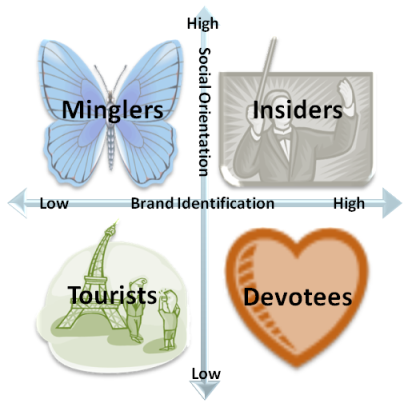If you are a socially savvy brand, most likely you are already engaging your customers in some form of online community, either through your own branded online community such as Kraft Foods’ recipe exchange community, or through a third-party social media platform such as what Starbucks is doing on Twitter. In managing the participants in these communities, it can be very helpful to segment the participants so that you can identify the unique value of each participant and involve them accordingly. In this three-part series, I would like to discuss a four-segment scheme that you can implement in your online community. The origin of this four-segment scheme came from Professor Robert Kozinets’ early work on online communities. Although the original idea was published a while back in 1999, it is still a classic for managing communities today.

Brand Community in Four Segments
To create the four segments of community participants, we need to look at two factors:
• Brand identification: how involved the user is with your brand name. This relates closely to brand loyalty. Those high on brand identification are likely to be your most loyal customers.
• Social involvement: how much does the user value social interaction with others in the community. This reflects the social orientation of the user, and distinguishes the familiar poster vs. lurker dichotomy.
With these two factors, we can create four segments of users: tourists, devotees, minglers, and insiders. The table below lays out the difference among the four segments.
| Tourists | Devotees | Minglers | Insiders | |
|---|---|---|---|---|
| Brand Identification | Low | High | Low | High |
| Social Orientation | Low | Low | High | High |
| Profile | Potentially discovered the community by accident; temporarily participate in the community out of curiosity, novelty, and variety seeking; superficial participation that usually does not last very long | Joined the community out of passion for the brand (think many Linux users); may participate often but in non-public forms; take satisfaction in the rich brand resources provided by the community | The polar opposite to devotees; these social butterflies choose communities that fulfill their social needs best but have no or minor interest in the brand/topic; help keep a community alive and active but may sidetrack often | True leaders of a community that are both passionate about the brand and sensitive to social well-being of the community; well respected by other community members and may self-select as community moderators; frequent and highly visible participation |
| Community status/influence | Low | May be respected within small circle but mostly unknown | Highly visible but influence limited | High |
| Network position | A small number of superficial network connections | A small number of potentially deep network connections | A large number of superficial network ties | A large number of deep network ties; high prestige within the network |
Although the original four-segment scheme gave a good description of these different types of users, it did not say much about how to identify each of the segments in practice. To make the idea more practical and applicable, in part 2 of the series, I will talk about how you can identify each of these segments through observable actions in your community, and then in part 3, how you should engage each of these segments differently. So stay tuned.
If you find this four-segment scheme interesting, I strongly recommend you to read Professor Kozinet’s original work on this topic. Although some of the community types mentioned in the work are outdated, the basic ideas are still invaluable to managing today’s online communities. Here is the reference and a download link:
Kozinets, Robert V. (1999), “E-Tribalized Marketing?: The Strategic Implications of Virtual Communities of Consumption,” European Management Journal, 17 (3), 252-64.
2 thoughts on “Segment Your Brand Community Participants Part 1”
Comments are closed.